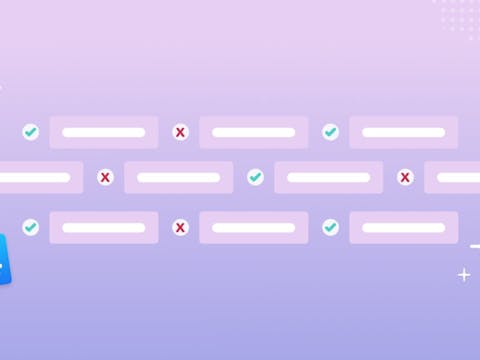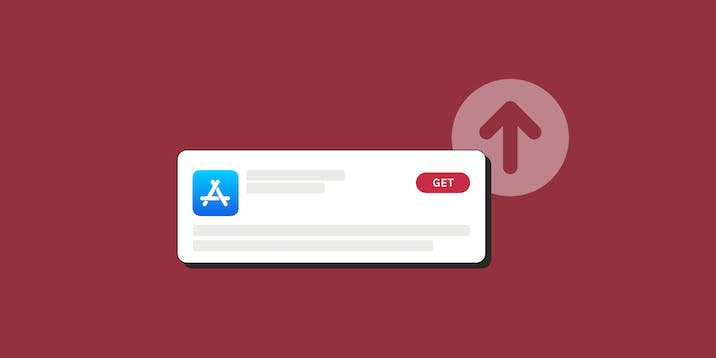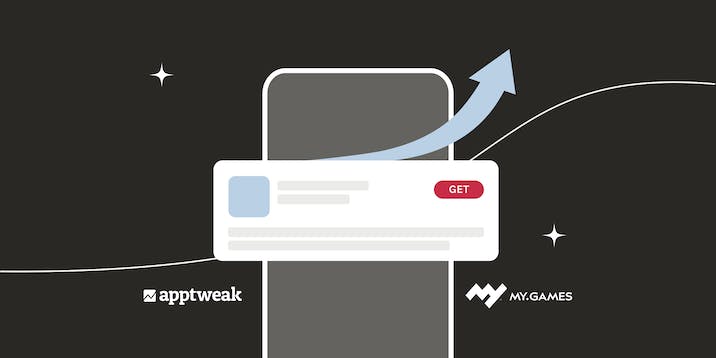
How to Select the Best Keywords for Your App
So you’ve decided to optimize your app metadata and are wondering how to identify the most relevant keywords for your app? Keep reading this blog!
One of the cornerstones of App Store Optimization (ASO) is keyword optimization, the process of researching, analyzing, and selecting the right keywords to include in an app’s title, subtitle/short description, keyword field (iOS), and long description.
In this blog, we’ll explain every step of the keyword optimization process in detail. We’ll also tell you exactly which AppTweak features, with a focus on our upgraded Optimize Metadata tool, will help you facilitate your work:
- Research: Build a keyword list
- Prioritize: Define the top keywords to include in your metadata
- Target: Add keywords to the different metadata, keeping in mind store ranking factors
- Monitor: Monitor, measure, and iterate
Step 1: Conduct keyword research
This step may seem obvious but it is the most crucial, as the subsequent actions depend on its success! The keyword optimization process starts by building an extensive keyword list of around 150-200 keywords. This exercise will ensure that you are not missing any relevant keywords that have the potential to drive downloads to your app.
Start by brainstorming keywords. Think of the words you use when describing your app, its features, as well as the keywords used by your competitors. Also, take a look at the keywords used in your reviews (if your app has already been published on the stores) and competitors’ reviews to better understand how users describe your app.
Learn how to conduct effective app keyword research on AppTweak
 On AppTweak, you can easily build a keyword list of 150-200 keywords in no time.
On AppTweak, you can easily build a keyword list of 150-200 keywords in no time.
Step 2: Prioritize keywords using our KPIs
Now that you’ve created a preliminary list of potential keywords, you need to sift through them and select the most strategic singular and combination keywords that will increase your app traffic and organic installs. These are the key indicators you should account for when selecting your target keywords:
Relevance
Only select keywords that are relevant to your app. Relevant keywords describe your app’s functionality and are the most likely to be used by users searching for your app on the app stores. Incorporating the keywords most relevant to your app in your metadata will also increase your conversion rate and ranking, as the app stores choose to show the apps that are the most relevant to users’ search queries.
Search Popularity (Volume)
Selecting relevant keywords for your metadata is great—but if no one searches for these keywords in the first place, your ranking will not improve! Keep in mind that the whole purpose of ASO is to increase your app’s visibility. You should therefore make sure that you only prioritize keywords that people are actually using when conducting searches on the app stores. For this, be sure to use volume estimates provided on AppTweak for all keywords worldwide.
Ranking Difficulty & Chance
Another KPI that is crucial to the keyword selection process is the ranking difficulty. It is no surprise that high-volume keywords are the most competitive, and the more competitive a keyword is, the more difficult it is to rank on. As a result, you should target high-volume keywords that you have a chance to rank on; it’s better to rank #1 for a lower volume keyword than #100 for a very popular word, as the goal is to gain visibility.
How to use AppTweak to choose the best keywords for your app
Two sections in our Keyword tool should be your go-to’s when prioritizing your keywords: the Keyword Table and Optimize Metadata. You’re probably already familiar with our Keyword Table which allows you to see many important metrics at the same time (such as those mentioned above) and compare rankings and installs between your apps and your competitors.
However, we have recently launched a new feature called Optimize Metadata that will make your keyword selection process even smoother! It works best when you have already conducted your research and built a complete keyword list (comprised of 30 keywords minimum), and if you’ve added at least two competitors.
 AppTweak’s Optimize Metadata feature.
AppTweak’s Optimize Metadata feature.
Once you land on the Optimize tab, you’ll see your active keyword list in the table on the right. You can configure the KPIs and select only the ones you want to consider (volume, rank, relevancy, etc) adding to your metadata.
AppTweak’s new Recommendation metric
We’ve also added a new column called “Recommendation” that will suggest the keywords we think you should add to your metadata. This is an indicator between 1 (low) and 4 (high) that considers the Keyword Efficiency Index (KEI), rankings, and downloads of your app and your competitors. You should also keep these factors in mind when considering our recommendations:
- Your own brand terms will have the highest scores.
- Your competitors’ branded keywords will have the lowest scores.
- We won’t recommend keywords with a volume lower than 8.
Step 3: Target keywords in your metadata
Now that you have a small list of relevant, high-volume, low-competition keywords, the next step is to add them to your metadata. You need to arrange your keywords carefully, as keywords do not carry the same weight across all metadata positions (title, subtitle/short description, keyword field, long description).
Learn more about how to optimize each metadata field on the App Store and Google Play
 Impact of keywords in the app title, subtitle, keyword field, and long description on traffic and conversion.
Impact of keywords in the app title, subtitle, keyword field, and long description on traffic and conversion.
On both the App Store and Google Play, keywords placed in the title have the highest weight in the ranking algorithm and thus the strongest impact on traffic. Therefore, you should place your top-priority keywords in the title to maximize visibility. Keywords placed in the long description do not rank on the App Store but do have a strong impact on visibility on Google Play. Try to include important keywords in the first few lines of your Android app’s long description to maximize visibility.
When crafting metadata, you should always try to balance traffic and conversion. The title not only has the highest weight on the ranking algorithm, but it is also the most visible element of your app page on both stores and thus can strongly impact your app’s conversion rate. As a result, make sure to optimize your title with the priority keywords that describe to users what your app is about.
As shown in the image above, keywords placed in the iOS keyword field do not impact conversion. These keywords are not visible on the app page, and you can optimize this metadata with the sole purpose of increasing traffic.
How to use AppTweak to target the right app keywords
In Optimize Metadata, the left panel will help you go from theory to practice! There, you can write and compare drafts for your title, subtitle, and keyword field for iOS, or for your title, short description, and long description for Android.
47b6.png) Optimize Metadata worksheet.
Optimize Metadata worksheet.
Here are the features you should consider when working on your metadata drafts:
- Character count: You should use as many characters as possible to target the most keywords possible. AppTweak will tell you when you reach the character limit.
- The Total Market Installs (TMI): This indicator provides an estimation of all the installs generated for the whole market by the keywords you target. Targeting high-volume keywords with lots of combinations will increase your TMI, but beware—this doesn’t mean you will rank for all of them. The TMI acts as a proxy for the volume to consider all the combinations in your list.
- Add keywords you were not following: We’ll show the keywords you wrote in your drafts but that have not yet been included in your list. Click on these keywords to add them to your list and you’ll see all their metrics in the table on the right.
- Comparison table: You can expand or hide a table that will always show you the difference between your current metadata version and the selected draft.
Last but not least, keep in mind that the store rules change over time and you might not always remember all of them. But don’t worry—some warnings will appear if you don’t respect the store’s guidelines or ASO best practices when writing your metadata. For example, we’ll highlight that you shouldn’t include your competitors’ brand terms or add the same keyword to both your title and subtitle on iOS. AppTweak has you covered!
 Optimize Metadata worksheet warnings.
Optimize Metadata worksheet warnings.
Step 4: Monitor your keyword optimization work
Keyword optimization is an ongoing process that requires continuous updating, testing, and iterating. Having updated your metadata according to your ASO strategy, you can now start tracking your progress. We recommend keeping your new metadata for at least 3-4 weeks in order for the algorithms to stabilize your app’s ranking for all the keywords you added, before assessing your performance and making iterations.
Keep in mind that both stores have different algorithms and you might see a different impact between the two:
- The App Store algorithm implements the changes as soon as the app is released, meaning that an app can go from unranked to ranked in a matter of seconds. However, these rankings are variable during the first few weeks because the algorithm is still testing how your app converts on different keywords.
- On Google Play, changes will not be visible for weeks because the algorithm is slower to pick them up.
Understand how often you should update your app’s metadata
How to use AppTweak to monitor keyword performance
To monitor your rankings for targeted keywords, many sections on AppTweak can be extremely useful:
- The Visibility History will provide you with a general overview of your performance evolution and go more in-depth on ranking history by app.
- Keyword Impact will allow you to focus on downloads, use filters, and compare growth between two dates.
- Brand vs Generic will let you analyze the split between your branded and generic keywords.
- And of course, Optimize Metadata!
In Optimize, your current metadata will automatically be fetched (except the iOS keyword field, which you need to add manually). If the keywords present in your current version are included in your active keyword list, a colored dot will appear next to them. You can then use the filters above the table to see only those keywords; no need to type each keyword individually, as you’ll be able to see how they perform (rankings, installs) in a second! What’s even better is that the same behavior will apply for the keywords added to your drafts. Therefore, you will be able to instantaneously compare the keywords added to or removed from your metadata.
ASO with AppTweak Course & Certification
Authenticate your ASO and AppTweak knowledge with a certification!
Get certified*Available to Power and Enterprise plans only.
Understanding and optimizing your keywords’ performance is key to achieving your ASO goals! With our Optimize Metadata feature, you’ll be able to write and compare drafts for your title, subtitle, and keyword field for iOS, or for your title, short description, and long description for Android! When writing your metadata, you may also see our comments or warnings to help you stay up to date with the latest app store rules and best practices.
Don’t miss out on this opportunity to optimize your keyword performance!



 Emily Sugrue
Emily Sugrue
 Mariia Chernoplyokova
Mariia Chernoplyokova


 Sarah B. Touimi
Sarah B. Touimi
 Yuliya Tsimokhava
Yuliya Tsimokhava